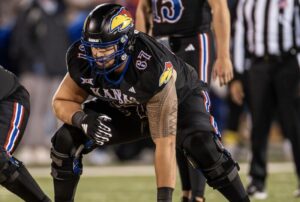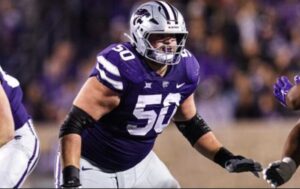Russell Street Report’s draft positional series continues, shifting the topic to tight ends.
The first installment of the series was a preview of the running backs. Click here to read it.
The tight end position figures to be one the Baltimore Ravens will address in next month’s NFL draft, with only one established tight end – Dennis Pitta – on the roster.
Drafting a tight end could come sooner than later for the Ravens, as pairing a high-caliber player with Pitta could pay off huge in the long run and next season, potentially upgrading both the passing game and run-blocking efficiency.
If there is a certain type of tight end you’d like to see the Ravens draft, take a look at the guide below for an idea of which prospects could fulfill which roles.
COMPLETE TIGHT ENDS
Jace Amaro, Texas Tech – The most complete tight end in this draft, Amaro is a multi-dimensional player who can line up in the slot and be a vertical threat, or line up next to a tackle and be either a reliable blocker or down-the-seam receiver. He has the athleticism to be a capable receiver at all levels, and his blocking ability is more than adequate enough to allow him to line up anywhere on the field.
Troy Niklas, Notre Dame – A player who is more “potential” than “finished product” right now, Niklas only has two years of experience at tight end, which makes him an intriguing “upside” option. A former offensive lineman in high school, Niklas’ background as a blocker is evident, and Notre Dame used Niklas too much in that role, often having him pass protect instead of being used as a receiver on passing plays. When given the chance to showcase his receiving capability, Niklas’ athleticism was noticeable down the middle of the field, and his ability to high-point the ball made him a capable red zone threat. Niklas possesses the most room for growth of any tight end prospect.
Arthur Lynch, Georgia – Often an afterthought in this year’s tight end class, Lynch provides all of the qualities needed to be a complete tight end in the NFL. His nastiness and dependability as a blocker make him a capable in-line type, and his large build and soft hands allow him to be a capable receiver at most levels of the field. The drawback is he may be the most maxed out tight end prospect, meaning there isn’t much more room for growth in his game. He’s an average athlete and will be 24 during his rookie season, so what you see is what you’re going to get with Lynch. But what he provides right now is still enough to make him a capable day three pick if available.
[youtube]http://youtu.be/A62AKY8Yjpc[/youtube]
HIGH RISK, HIGH REWARD
Eric Ebron, North Carolina – Elite athleticism and explosive after the catch. Those two qualities alone make Ebron a desirable prospect, but his hands are a complete turnoff, and raise questions about whether or not he can be consistent enough to be a legitimate offense-changing weapon. Ebron’s adequate but limited blocking ability and ideal “Joker” projection figures to lead to a Pitta-like role in the NFL, which isn’t exactly what Baltimore needs.
[youtube]http://youtu.be/ae1-I8LR6FQ[/youtube]
BLOCKING TIGHT ENDS
Austin Seferian-Jenkins, Washington – Once considered a complete, top-tier prospect, Seferian-Jenkins’ 2013 season showed his limitations in the passing game, but also his intriguing qualities as a blocker. His average athleticism and thick build make him a more viable in-line blocker than a true receiving threat. Seferian-Jenkins is a dependable blocker though, and could excel in that role.
C.J. Fiedorowicz, Iowa – Just missing out on the “complete tight end” category, Fiedorowicz is an imposing, consistent blocker who also provides plenty of value in the passing game. His route tree at Iowa was limited to the short and intermediate passing game, and how consistent of a threat he can be down the field remains to be seen. At the very least, Fiedorowicz is a prototypical blocker who provides reliable hands in the short passing game.
[youtube]http://youtu.be/jJJ4UFxs7M0[/youtube]
RED ZONE THREAT
Crockett Gilmore, Colorado State – This year’s tight end class doesn’t provide many players who are glaring mismatches in the size game, but one prospect who has that potential is Gilmore, a 6’6, 260-pound tight end with long arms, huge hands and explosiveness for his size. His reliable hands make him a viable red zone threat, someone who can be what Joseph Fauria was for the Detroit Lions last season. The Ravens desperately needed production in the red zone last season, and Gilmore provides that potential.
RECEIVER ONLY
Richard Rodgers, California – He could also fall in the “high risk, high reward” category, but since Rodgers is the least developed of the tight ends, he is essentially a wide receiver for now. A tall, lengthy player, Rodgers was a glorified receiver in California’s offense, and fitting in with his team’s offense took away the tight end qualities. He wasn’t utilized as a blocker on many occasions, and when he was, the weight disadvantage was often noticeable. A true project, expecting Rodgers to contribute in his first year as a tight end would be too optimistic, and ultimately his upside will only take shape via coaching and his personal development into a more well-built body. Strictly a Joker in the NFL for now, Rodgers doesn’t fit what Baltimore needs, but still makes the list for potential value.
Which tight end would you like to see in Baltimore?








